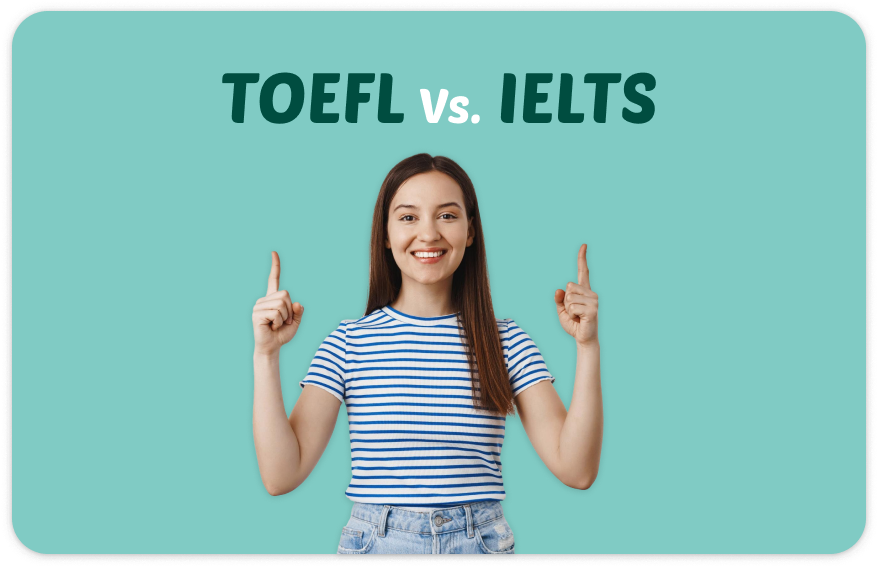
Cost of Studying in France for Indian Students
Have you ever dreamed of studying in France, walking down cobblestone streets after class, sipping coffee at a cosy café, and soaking in the culture while working on your next project?
Share this Article

Table of contents
Thinking about studying abroad but can’t decide which English test to take? You’re definitely not alone. Loads of students get stuck trying to choose between TOEFL and IELTS. It’s totally normal since both tests check your English skills and are accepted pretty much everywhere.
The wrong test can not only waste your time, but also money, and effort. Not all tests suit to your learning style or the country you want to study in. In this blog, we’ll explain the key difference between TOEFL and IELTS to help you pick the best fit. This will make your preparation easier and boost your chances of scoring well.
IELTS and TOEFL, these two are the widely accepted English language tests that evaluate your listening, reading, writing, and speaking skills. Both the tests are trusted by renown universities, employers, and immigration authorities worldwide.
ELTS offers both paper-based and computer-based options while TOEFL is primarily computer-based. While both the tests asses your English proficiency, each test has its own format and scoring system. Understanding these basics can help you choose the test that best fits your needs.
| Feature | IELTS | TOEFL |
|---|---|---|
| Question Types | Multiple choice, fill in blanks, short answers, matching | Mainly multiple choice |
| Variety | High variety in question formats | Limited to mostly multiple choice |
| Best For | Students who like different question types | Students who prefer consistent format |
| Feature | IELTS | TOEFL |
|---|---|---|
| Format Options | Paper-based or Computer-based | Computer-based only |
| Writing Method | Pen/paper or typing | Typing only |
| Screen Time | Limited (if paper-based) | 2+ hours of screen time |
| Comfort Level | Natural for paper lovers | Better for tech-comfortable students |
| Feature | IELTS | TOEFL |
|---|---|---|
| Total Time | 2 hours 45 minutes | 2 hours |
| Scoring System | Band scores 0-9 | Points 0-120 |
| Score Increments | 0.5 increments (6.5, 7.0) | Whole numbers only |
| Section Scoring | Individual band per section | Points per section (0-30) |
| Feature | IELTS Listening | TOEFL Listening |
|---|---|---|
| Duration | 30 minutes + 10 min transfer | 41-57 minutes |
| Recordings | 4 recordings | Multiple lectures & conversations |
| Accents | British, Australian, American, Canadian | Mainly American |
| Content Type | Everyday + academic situations | Academic lectures & campus talks |
| Questions | 40 questions | Varies (30-40) |
If you watch movies and shows from different English-speaking countries, IELTS listening will feel familiar. If you mostly listen to American English, TOEFL might be easier.
| Feature | IELTS Reading | TOEFL Reading |
|---|---|---|
| Time Limit | 60 minutes | 54-72 minutes |
| Passages | 3 passages | 3-4 passages |
| Questions | 40 questions | 30-40 questions |
| Question Types | Multiple choice, matching, completion | Mostly multiple choice, text insertion |
| Content Source | Books, magazines, newspapers | Academic texts only |
Students who like variety prefer IELTS reading. Those who find multiple choice easier lean toward TOEFL.
Writing tasks check your ability to explain ideas. IELTS tests writing separately, TOEFL mixes reading and listening with writing.
| Feature | IELTS Writing | TOEFL Writing |
|---|---|---|
| Duration | 60 minutes | 50 minutes |
| Tasks | 2 tasks | 2 tasks |
| Task 1 | Describe chart/graph OR write letter | Read + Listen + Write (integrated) |
| Task 2 | Essay on given topic | Independent essay |
| Skills Tested | Writing skills separately | Combined reading, listening, writing |
IELTS assesses each skill independently, while TOEFL often combines skills. If you like keeping skills separate, choose IELTS. If you can handle combining reading, listening, and writing together, TOEFL works well.
Speaking tests how well you talk in English. IELTS is face-to-face, and TOEFL is recorded on a computer.
| Feature | IELTS Speaking | TOEFL Speaking |
|---|---|---|
| Format | Face-to-face with examiner | Computer-recorded |
| Duration | 11-14 minutes | 17 minutes |
| Parts | 3 parts (intro, topic, discussion) | 4 tasks |
| Interaction | Real conversation | Speaking to microphone |
| Comfort Level | Natural for most people | Good for shy students |
Speaking with a real person can feel more natural, while speaking to a computer might suit those who prefer less direct interaction. Now, let’s look at how each test is scored to understand what you need to achieve.
Here’s how scoring works for both tests. IELTS gives you band scores from 0 to 9 for each section. Your overall score is the average of these four sections, and you can get half bands like 6.5 or 7.5 to reflect your exact level.
TOEFL scores each section from 0 to 30 points. Your total score is simply the sum of all four sections, which means it ranges from 0 to 120.
| IELTS Band | TOEFL Score | University Level |
|---|---|---|
| 9.0 | 118–120 | Expert level |
| 8.5 | 115–117 | Very high level |
| 8.0 | 110–114 | High level |
| 7.5 | 102–109 | Good level |
| 7.0 | 94–101 | Competent level |
| 6.5 | 79–93 | Modest level |
| 6.0 | 60–78 | Limited level |
Most universities look for IELTS scores between 6.5 and 7.0 or TOEFL scores from 80 to 100 if you’re applying for an undergraduate program. For graduate studies, you’ll usually need to aim higher.
So, keep these score ranges in mind when choosing which test to prepare for.
| Test | Fee in India | What’s Included |
|---|---|---|
| IELTS | INR 18,000 | Score reporting to 5 organizations |
| TOEFL | INR 16,900 | Score reporting to 4 institutions |
| Feature | IELTS | TOEFL |
|---|---|---|
| Validity | 2 years | 2 years |
| Score Reports | Available online | Available online |
| Additional Reports | INR 3,200 each | $20 USD each |
There’s no single right answer, as both IELTS and TOEFL are accepted worldwide. What matters most is checking which test your target universities prefer, since that can guide your choice.
When it comes to personal preference, if you like variety in question types and speaking to a real person, IELTS might feel easier for you. It’s also a handwritten-based test. On the other hand, if you’re more comfortable with computers and prefer a consistent, mostly multiple-choice format, TOEFL could be the better fit.
Choosing between IELTS and TOEFL is simple. Both tests help you get into good universities worldwide. They check your English skills for studying abroad. The main differences are the test format, the accents you hear, and how speaking is tested. Neither test is harder than the other. Choose the one that feels easier for you and fits the country where you want to study. With practice, either test can help you reach your goal.
Want to study abroad? QCK Loans can help with quick loan approvals and low interest rates. Many students have used us to start their journey. Don’t let money stop you. Contact QCK loans, today!
Need Help in education loan
Latest article

Cost of Studying in France for Indian Students
Have you ever dreamed of studying in France, walking down cobblestone streets after class, sipping coffee at a cosy café, and soaking in the culture while working on your next project?

10 Best Universities in Germany for Indian Students
Thinking about studying in Germany but not sure which university to choose? You’re not alone. With hundreds of world-class institutions and countless courses to explore, it’s easy to feel lost when deciding where to apply.

Top PhD Scholarships for Indian Students to Study Abroad
You’ve probably dreamt of doing your PhD at a top university somewhere abroad. Sounds exciting, right? But once you start checking the tuition fees, research costs, and living expenses, that dream suddenly feels a little too expensive. For many Indian students, it almost seems out of reach.
WhatsApp us